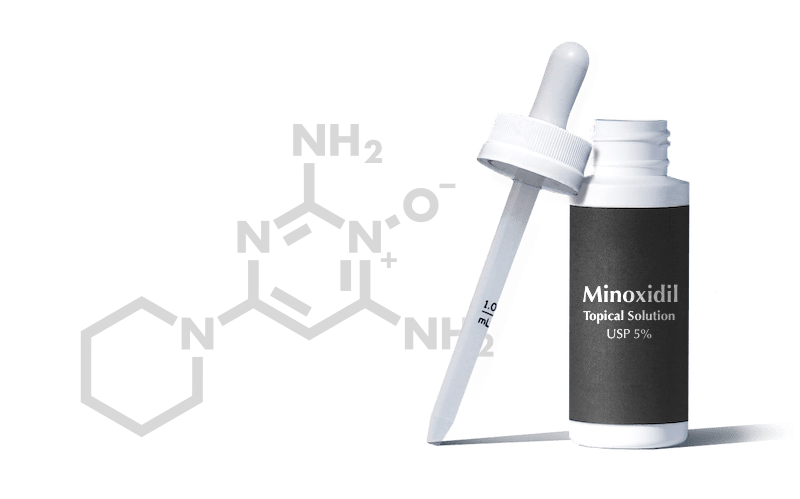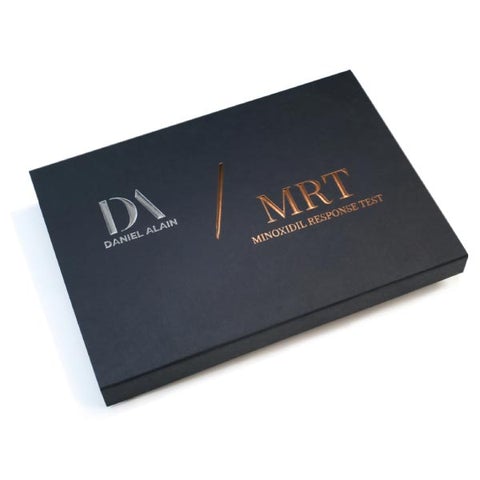Hair Shedding | Hair Loss Testing | Hair Loss | Men's Minoxidil | Women's Minoxidil
What is Minoxidil & What is it Used For?

What is Minoxidil Used For?
You’ve heard of Rogaine®, but what is Minoxidil? Minoxidil is the generic form of brand-name Rogaine®. It is an FDA-approved topical solution and foam used to treat hair loss in men and women with androgenetic alopecia, also known as pattern hair loss or hereditary hair loss. With daily, ongoing application, Minoxidil may stop hair loss and thinning and increase hair density, making hair feel thicker. However, despite clever marketing slogans boasting its effectiveness, Minoxidil doesn’t work for everyone.
“ Will Minoxidil work for me?”
This is a question on many people’s minds, and the answer is that it depends. If you’re struggling with genetic hair loss, you may be a candidate, but you must have the necessary scalp enzymes to activate the solution, which we’ll cover in more detail in this article.
Studies on Minoxidil’s success rate are conflicting, but the truth is that it isn’t a one-size-fits-all solution. If the solution takes effect, it can take upwards of 6-9 months to start seeing results, and that’s only if you have hereditary hair loss and the enzymes that respond and activate Minoxidil. For those who don’t see results, it’s a daunting, emotional experience riddled with time and money wasted. Worse, investing in a product that ultimately doesn’t work is nothing short of disappointing.
Understandably so, many people using Minoxidil feel stumped, asking themselves for months on end, “How Do I Know if Minoxidil is Working?"
Here at Daniel Alain, we’re devoted to transparency and giving you all of the facts undiluted. The truth is, Minoxidil doesn’t work for everyone.
But with the Minoxidil Response Test, you can now know with complete confidence whether or not Minoxidil will work for you. Our MRT kit was designed to save you time and money and help you ditch the dreaded waiting game once-and-for-all!
So, what is Minoxidil used for, and will it work for you? Keep reading to find out!
How Does Minoxidil Work?
What is Minoxidil’s mechanism of action, and why does it help some people regrow lost hair? Topical Minoxidil is applied to the scalp with a dropper or foam solution. The solution dilates blood vessels in the scalp to open and receive the necessary growth agents — oxygen and nutrients — to stimulate hair growth.
Okay, so what is Minoxidil used for on a biological level?
Hairs migrate across the four phases of the Hair Growth Cycle: Anagen (growth), Catagen (transitional), Telogen (resting), and Exogen (shedding). At the end of a healthy functioning cycle, cells divide and re-enter the anagen phase to produce new hairs.
When people experience genetic hair loss, the Anagen phase becomes progressively shortened, and the follicles miniaturize, causing hair loss.
Researchers speculate that Minoxidil solution alters the biological course of Androgenetic Alopecia by increasing intracellular Ca2+ and up-regulating the adenosine triphosphate (ATP) enzyme synthase. Simply put: Minoxidil prolongs the Anagen phase.
If you’re a responder, Minoxidil should start to show signs of regrowth within 3-9 months, depending on the concentration and whether or not your scalp is responsive. The surest way to determine whether or not you have the enzymes required to respond to treatment is to take our Minoxidil Response Test, which is 95.9% accurate, so you can have peace of mind choosing the best course of action for your specific hair loss.
Does Minoxidil Work for Everyone?
Minoxidil only works for those with genetic alopecia and the SULT1A1 enzyme. Before the groundbreaking Minoxidil’s effectiveness was largely speculative and misinterpreted.
In early trials on the solution’s efficacy on male pattern baldness, 40% of participants reported moderate to dense regrowth on the crown of the scalp, where hair loss is most prevalent in androgenetic alopecia.
What about women? In a 48 week trial of 5% and 2% topical Minoxidil used to treat women with female pattern hair loss, the 5% solution proved superior over the 2% solution, which was indistinguishable from results the placebo group reported.
Still, only 19% of women saw moderate regrowth after eight or more months of application. Moreover, the largest portion of participants (40%) experienced minimal regrowth. But here’s the kicker: in this same study, 33% of women taking a placebo solution also reported minimal regrowth.
Bottom line? Minoxidil’s effectiveness as a hair loss solution is spotty, and this is primarily due to confusing study parameters and jumbled marketing touting it as “80% effective.”
It becomes increasingly confusing learning how to tell if Minoxidil is working or if the product works at all for some people.
If it does work, you’ll start to see signs after 3-6 months, and you may notice initial shedding, increased hair length, or the feeling of thicker hair. If it’s not working, you likely won’t see any changes in your hair’s density or length.
The surest way to know for sure is to take a test before starting treatment to ensure your scalp is responsive to treatment.
How Do I Know if Minoxidil Will Work for Me?
The only way to know with certainty whether or not Minoxidil will work for you is to take the Minoxidil Response Test. With our patented, lab-based test, you’ll pluck a few strands of hair which we’ll analyze in our lab. Your hair samples give us all the information we need to assess your scalp’s atmosphere and evaluate whether you have the SULT1A1 enzyme required for Minoxidil to work.
The test is non-invasive, affordable, quick, and validated with 95.9% accuracy. Above all, our Minoxidil test will offer you the confidence you can’t get anywhere else. Instead of investing your time, money, and hopes into Minoxidil only to discover it’s not working after months of painstaking waiting, you’ll know within seven to ten days of mailing in your hair samples.
That means that you don’t have to buy any solutions yet — you can first get tested and make an informed decision on how to best treat your hair loss.
If the results show that you’re a Minoxidil responder, you can confidently move forward with treatment. But what if the results show otherwise? While it can feel disheartening, there are other hair loss solutions available to you right now.
Frequently Asked Questions About Minoxidil
What Causes Hair Loss?
The majority of hair loss is due to genetics and hereditary hair loss. However, there are many causes of hair loss, including medications, medical illness, alopecia, stress, environmental exposure to pollutants, postpartum hair loss, menopause, seasonal hair shedding, traction and pulling, and dietary deficiencies.
Does Minoxidil Really Work?
Minoxidil works for about 40% of people and only treats androgenetic alopecia, also known as hereditary hair loss. While it is effective for some people, it doesn’t work for everyone, and you must have the necessary scalp enzymes to activate Minoxidil. If you have the SULT1A1 enzyme, Minoxidil will stimulate the cells within the follicles to divide and produce new hairs.
How Do I Know if Minoxidil is Working?
If Minoxidil is working, you may start to see signs around 3-6 months after repeated, twice daily application of foam or dropper 2-5% solution. Signs Minoxidil is working include initial hair shedding followed by increases in hair density, making hair feel thicker, and longer hairs.
How Long Does it Take for Minoxidil to Work?
It can take anywhere from 3-9 months for Minoxidil to start working. You must apply the topical solution twice a day to begin to see results. After 4-6 months, you may start to see less shedding and new hair growth.
Should I Use Minoxidil?
You should only use Minoxidil for hair loss if you have genetic hair loss (androgenetic alopecia) and have the appropriate scalp environment, including the necessary SULT1A1 enzyme, for Minoxidil to work. You can discover if Minoxidil will work for you by taking the Minoxidil Response Test, the only test available in the market that analyzes your scalp hairs in a lab to discern whether or not you are a Minoxidil responder.
What are the Side Effects of Using Minoxidil?
In clinical trials, Minoxidil side effects were minimal. However, some people report symptoms including a burning sensation on the scalp, hair loss, scalp acne, facial hair growth, scalp inflammation, redness, chest pain and palpitations, light-headedness, flushing, headaches, dizziness, confusion, and swelling.
Does Minoxidil Thicken Hair?
If Minoxidil works for you and you have genetic hair loss and the SULT1A1 enzyme required for the treatment to activate on the scalp, Minoxidil can increase hair density, making hair feel thicker and stronger.
Do You Have to Use Minoxidil Forever?
Yes, if Minoxidil works for you, you will have to apply the solution twice daily indefinitely to retain hair growth. If you stop using the solution, your hair will eventually return to the status it was in when you initially began applying the topical hair growth solution.
Will Minoxidil Ruin My Hair?
When you first begin applying Minoxidil topical solution, whether 2% or 5%, you may notice an increase in hair shedding. This happens because Minoxidil accelerates the resting phase of the Hair Growth Cycle, causing hairs to die and fall out quickly to make way for new hairs to grow.
Who Should Not Use Minoxidil?
You should not use Minoxidil if you have another form of hair loss that isn’t caused by genetics. Minoxidil only works for people with hereditary hair loss. Minoxidil is not safe for pregnant women or women planning to become pregnant. Breastfeeding mothers should not take Minoxidil, as it’s unknown whether the treatment is a risk to infants. Children and teenagers should not take Minoxidil. To be safe, it’s best to consult with your dermatologist before proceeding with Minoxidil treatments.
Why Isn't Minoxidil Working for Me?
If you do not see positive results or regrowth from Minoxidil, it could be that it’s too soon to see results. Minoxidil takes up to nine months to begin showing signs of regrowth. If you’ve recently started applying topical Minoxidil solution and notice more shedding, Minoxidil is working to push out old hairs and make room for new hair growth. If after nine months you’ve seen no signs of hair regrowth or increases in hair density, it could be that you are a non-responder lacking the necessary enzymes to convert and activate Minoxidil.
How Does Minoxidil Testing Work?
You can take a test to find out if you have the right scalp environment for Minoxidil to work. The Minoxidil Response Test analyzes your hair strands in a CLIA-certified lab and looks for the required enzymes needed for Minoxidil to work. Your scalp must have the SULT1A1 enzyme to activate and respond to Minoxidil solution. The test analyzes six hair specimens taken from a thinning area on the scalp and removes any mystery as to whether Minoxidil will work for you. You’ll receive results within seven to ten days.
How Much Does Minoxidil Testing Cost?
There is only one Minoxidil Response Test on the market, and it costs $139. Taking the test is an affordable, convenient way to discover if your scalp has the required enzymes for Minoxidil to work for you. The investment into the test kit will protect you from investing hundreds of dollars over time into a product that may not work for you, as Minoxidil only works for around 40% of people.
Where Can I Get a Minoxidil Response Test?
Daniel Alain’s Minoxidil Response Test is the only available test in the market, offered by the leading authority in hair loss science and solutions. Our painless, non-invasive test is validated with 95.9% accuracy. You’ll receive results in seven to ten days, and the results are accurate and confidential. With the results, you’ll know whether or not you’re a Minoxidil responder.


